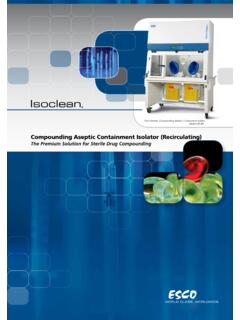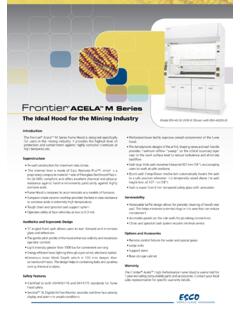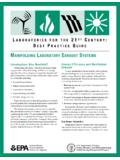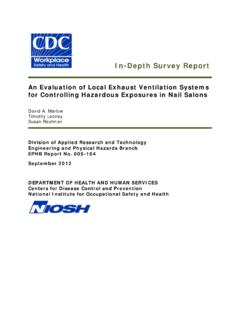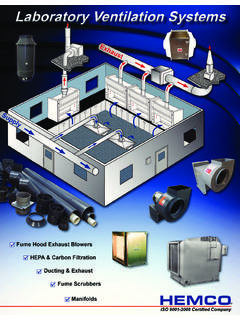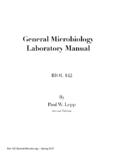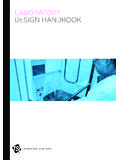Transcription of A Guide to Laboratory Fume Hoods - Esco
1 A Guide to Laboratory fume Hoods INTRODUCTION. Laboratory fume Hoods are a type of ventilation system with the primary function to exhaust chemical fumes, vapors, gasses, dust, mist and aerosol. fume Hoods also serve as physical barriers between reactions and the Laboratory , offering a measure of protection against inhalation exposure, chemical spills, run-away reactions and fires. A typical fume hood has a box like structure with a moveable sash window. Experimental procedures are performed within the hood which is consistently and safely ventilated, usually by means of an extract blower and ductwork. Chemical fumes are exhausted and diluted many times over in the atmosphere and have a negligible effect on human health. When environment concerns are of importance, an extract treatment system, often referred to as a scrubber is installed to remove most of the vapors from the exhaust air stream. The hood functions by maintaining a relatively negative pressure in the interior of the hood to prevent any contaminant from escaping while drawing air in through the hood opening at a consistent rate.
2 A suitable hood face velocity (the speed at which air is drawn into the hood ) is of importance to the safe and effective operation of a fume hood . 2. While excessive face velocities can often result in turbulence and reduce containment, insufficient velocities can also compromise hood performance. In general, a hood 's face velocity is recommended to be between m/s (60 fpm) and m/s (100 fpm), however it is important to check with local safety regulations on the face velocity recommendation before using the fume Hoods . Most Hoods are commonly sized for a minimum face velocity at full sash opening; but as means to conserve energy some Hoods size the minimum face velocity of the hood at half-sash opening creating new low flow fume Hoods , which are now present in the market. Types of fume Hoods General Purpose, Bench Top fume hood Distillation fume hood A distillation hood is characterized by a low worktop height which results in a large working height for the operator.
3 This allows tall distillation equipment to be installed and mounted in the work chamber. Otherwise, it has similar features to that of a standard fume hood . Perchloric Acid fume hood Perchloric acid reacts violently with organic materials. Dried perchloric acid is also highly explosive. Therefore, perchloric fume Hoods require built-in water wash down systems in order to prevent perchlorate salt deposits. Interior liners are made of acid resistant materials like stainless steel. Interior corners are coved to aid in cleaning. All procedures that use perchloric acid must be confined to a perchloric fume hood , to prevent dangerous reactions with other chemicals. A Guide to Laboratory fume Hoods Introduction Radioisotope fume hood Radioisotope fume Hoods are constructed specifically to protect users from radioactive materials. They have specially constructed worktops to withstand the weight of lead shielding plates, and may also have lead laced sashes.
4 Interiors are made of stainless steel with coved corners to aid in decontamination. Acid Digestion fume hood Acid digestion fume Hoods have special liners manufactured of acid resistant materials such as unplasticized PVC. For acid digestion applications involving high service temperatures, other materials such as PVDF may be used. Sashes may be made of polycarbonate to resist hydrofluoric acid etching. Floor Mounted fume hood Floor mounted fume Hoods are used for applications which require large apparatus. As the name implies, these Hoods are floor mounted without any work surface. This facilitates the transfer of equipment and materials into, and out from the hood . Floor mounted Hoods are sometimes referred to, although wrongly, as walk-in fume Hoods . Demonstration fume hood A demonstration hood has all 4 sides made of safety glass, and this hood is commonly 3. used in educational institutions to allow students to easily view the teachers'.
5 Demonstrations inside the fume hood from all angles, enhancing efficiency in teaching laboratories. Ductless fume hood Ductless fume Hoods utilize activated carbon filtration to adsorb chemical vapors and fumes. These Hoods recirculate air to the Laboratory , and are growing in popularity because of energy savings and the green movement. Not fume Hoods Biological safety cabinets, laminar flow clean benches, pharmacy isolators and glove boxes are sometimes mistaken for fume Hoods . These devices utilize particulate filters which do not remove chemical vapors. With specific rare exceptions, they should not be used for work involving chemicals. Important components of a fume hood 6. 2. 1. 3. 7. 4. 4. 5. 1. hood Body The visible part of the fume hood that serves to contain hazardous gases and vapors. 2. Baffles Moveable partitions used to create slotted openings along the back of the hood body. Baffles keep the airflow uniform across the hood opening, thus eliminating dead spots and optimizing capture efficiency.
6 3. Sash The sliding door to the hood . By using the sash to adjust the front opening, airflow across the hood can be adjusted to the point where capture of contaminants is maximized. Each hood has its optimum sash configuration. The sash should be held in this position when working in the hood and closed completely when the hood is not in use. The sash may be opened completely to set up equipment, but must be returned to the optimum setting prior to generating contaminants inside the hood . Hoods are equipped with one of three types of sashes: Vertical Vertical sashes provide the greatest overall access and are the most common. A Guide to Laboratory fume Hoods Important Components of a fume hood Horizontal Horizontal sashes provide the best access to the top interior of the hood , but do not provide access to the entire width at the same time. However, they can be positioned as a body shield to protect the operator, while enabling access through the sides.
7 Combination vertical and horizontal Combination sashes combine horizontal sash panes, in a vertical rising frame. As such, they offer the advantages of both vertical and horizontal sashes. 4. Airfoil Located along the bottom and side edges the airfoil streamlines airflow into the hood , preventing the creation of turbulent eddies that can carry vapors out of the hood . The space below the bottom airfoil provides source of room air for the hood to exhaust when the sash is fully closed. Removing the airfoil can cause turbulence and loss of containment. 5. Work surface Generally a Laboratory bench top, or the floor in the case of a floor-mounted hood , this is the area where the work is conducted. 5. 6. exhaust plenum The exhaust plenum helps distribute airflow evenly across the hood face. Materials such as paper towels drawn into the plenum can create turbulence in this part of the hood , resulting in areas of poor airflow and uneven performance.
8 7. Face The imaginary plane between the bottom of the sash and the work surface. hood face velocity is measured across this plane. Important Facts about Laboratory fume Hoods fume Hoods should be suitably sited to ensure maximum containment. Locate Hoods to avoid crosscurrents at the hood face due to pedestrian traffic, doors and supply air diffusers. Sufficient Laboratory supply air must be available to allow Hoods to operate at their specified face velocities. A fume hood is not designed to contain high velocity releases of particulate contaminants unless the sash is fully closed. The hood is not capable of containing explosions, even when the sash is fully closed. If an explosion hazard exists, the user should provide anchored barriers, shields or enclosures of sufficient strength to deflect or contain it. Such barriers can significantly affect the airflow in the hood . A conventional fume hood must not be used for perchloric acid.
9 Perchloric acid vapors can settle on ductwork, resulting in the deposition of perchlorate crystals. Perchlorates can accumulate on surfaces and have been known to detonate on contact, causing serious injury to researchers and maintenance personnel. Specialized perchloric acid Hoods , made 6 of stainless steel and equipped with a wash down system must be used for such work. Many fume Hoods are equipped with flat or rounded sills or air foils which direct the flow of air smoothly across the work surface. Sills should not be removed or modified by the hood user. Objects should never be placed on these sills. Materials released from containers placed on the sills may not be adequately captured. In addition, an object on the sill may prevent the quick and complete closure of the sash in an emergency. Tubing is frequently used to channel exhaust to the hood from equipment located some distance away. This is not an effective control method.
10 Occasionally, a researcher may need local exhaust ventilation other than that provided by an existing fume hood . A new device may not be connected to an existing fume hood without the approval of the manufacturer. Adding devices to even the simplest exhaust system without adequate evaluation and adjustment will usually result in decreased performance of the existing hood and/or inadequate performance of the additional device. Work involving harmful microorganisms should be done in a biosafety cabinet, rather than a chemical fume hood . A fume hood should not be used for waste disposal. It is a violation of environmental regulations to intentionally send waste up the hood stack. A Guide to Laboratory fume Hoods Important Facts About Laboratory fume Hoods Guidelines for Using a fume hood Effectively Adequate planning and preparation is the key. The hood user should know the Standard Operating Procedure (SOP) of the hood and should design experiments so that the SOP.


